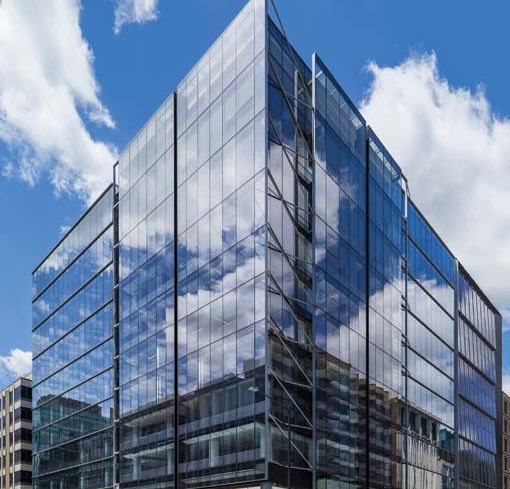Presented By: Rockefeller Group
How WELL Building Design and Certification is Helping 1901 L St Attract Tenant Demand
Future Of Office
By Rockefeller Group September 13, 2021 8:00 am
reprints
The 12-story, 212,000-square-foot office building at 1901 L Street NW, has recently undergone a major transformation.
Through a redevelopment designed by FOX Architects, the building just made history as the first WELL(v1)-certified building in Washington, DC.
Some aspects of the transformation are clearly evident including four new floors, a new energy-efficient glass-façade, and outdoor rooftop terrace space to reinvigorate employees throughout the day or into the evening. Less obvious, in the building’s infrastructure, strict criteria were followed from the outset to promote employee health and well-being that are now becoming essential to tenants in the post-pandemic workplace.
Sixteen months following completion, the building is already 72 percent leased to multiple tenants in diverse sectors, with a recent uptick in tour activity for the remaining 57,000 square feet that the owners attribute to interest in WELL.
Rockefeller Group, a co-developer of the project with The Meridian Group, connected us with Fox Architects Principal JP Spickler, FAIA, to discuss some of the key WELL aspects of the project, and how they’re helping 1901 L stand out.

Commercial Observer: What does it mean for a building to be WELL-certified?
JP Spickler: I’ll compare it to LEED, which is better known. LEED is focused on saving the planet. WELL is focused on the health and well-being of the inhabitants of a building. WELL status is something you need to identify early in the process. You can’t decide to do it halfway through.
What’s involved in designing a building for WELL certification?
WELL(v1) is evidence-based, and its certification is performance-based. There are 102 features in seven concepts, or areas of design strategy, and there are prerequisites in each of those seven categories: air, water, nourishment, light, fitness, comfort, and state of mind. Air, for example, is about indoor air quality: the monitoring of the indoor air, increasing ventilation, and delivery standards equivalent to outdoor air, because the indoor air has to be as good or better than the outdoor air. Water needs to be tested quarterly, and there’s a water management protocol that’s required. Under Fitness, WELL also encourages exercise and movement, so we added a bike lounge. WELL is intended to be holistic, and it’s focused on the inhabitants.
What are the greatest challenges to creating a WELL building?
Usually the air requisite. Mechanical systems – the air systems in a building – are complex. For the HVAC system, we installed a DOAS: dedicated outdoor air system. A DOAS system delivers 100 percent outside air to the indoor work environment. Most office buildings, even Class A, use a variable air volume system. That’s when some of that air is being re-circulated and moved around by fans, which takes up a lot of electricity. With DOAS, all the air coming into any environment is 100 percent outdoor air, and the air is being chilled with water. And, since you can move as much energy in a two-inch pipe as through a 24” x 24” air duct, a DOAS system creates a 28-32 percent reduction in electrical costs, because it’s more energy efficient. Over my 35 years of making corporate commercial architecture, people have learned that what’s good for the environment and for people also happens to be good for business. 1901 L now has an advantage over its competitors because it’s one of the healthiest buildings in the city.
Does this really have a meaningful impact on the health of the people who work in a WELL building?
They will have a comfort level and understand how the environment they’re in is functioning. There’s a website where you can see what strategies are being used in the building, and how they are being regularly monitored and documented to ensure your water, air, noise, and light are healthy. For WELL, you have to keep records and resubmit them every three years showing you did your regular mold inspections, water inspections, maintaining the air filtration, etc.
So if someone works in another DC office building then gets a job at 1901 L, will they notice the difference immediately?
I think it will start affecting them immediately, but they’ll realize more over time. Because if you’re here, you realize, oh, I’m not getting sick as often as I used to. I’m not getting the colds I used to get. I feel better now. Also, they realize they’re not fighting glare, which was an issue we had to address with lenses on light fixtures. So, some things you’ll notice immediately, and some things will take time.
1901 L was a redevelopment. Talk about the difference in the challenges between designing ground-up construction for WELL and turning an existing building into a WELL building.
We called 1901 L one of our recycling projects, because it was born out of the skeleton of a building built in 1978 that outlived its useful life span. Here’s an amazing statistic: fifty percent of the office buildings in our downtown cities nationally are more than 40 years old. Think about how we designed and built buildings in the 1960s and ‘70s. The HVAC systems, if you got 25 years out of them, you were lucky. The facades were a single pane of glass, and there was no sustainability. So what should we do with half of the office buildings in our downtown cities? We can’t tear them down and send them to the landfill, but we can make new trophy buildings out of them. That’s what I love about 1901 L. It’s the healthiest building in DC now as the first WELL-certified building, but it’s also an example of how to make a brand new building from pieces of an old one. We took an eight-story concrete frame that was salvaged – and you don’t want to make a new concrete frame, because that’s one of the worst things you can do to the environment – and we stripped the building down to that. Then we added four floors to the top and an entire structural bay. We added new skin, new systems, new facade, new public spaces, new amenities. So it’s a new building. We just used a lot of components of an old building.
Now that 1901 L has WELL status, do you think this will start a trend for other buildings to design for WELL status?
Absolutely. Brokers and tenants looking at occupying the building saw that it was a better, healthier environment. Commercial real estate is competitive. They wanted to do the same. So absolutely. It’s going to be a trend. It’s already started, and the pandemic is accelerating it.
View more articles on the Future Of Office here.


